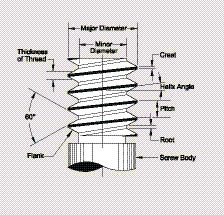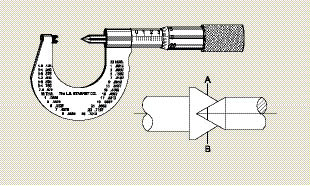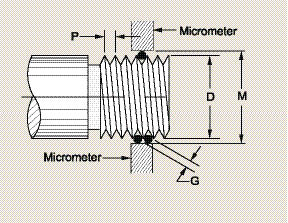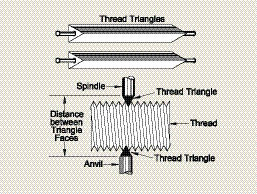Screw threads were used in the time of Plato, about 500 B.C., in grape and olive presses. About 100 years later, Archimedes was credited with inventing a water pump based on the screw to irrigate crops and remove water from ship bilges. Later, the Romans used this pump to dewater mines.
Until Jesse Ramsden, an English instrument maker, developed the first satisfactory screw-cutting lathe in 1770, all screw threads were cut by hand. This limited most threads to large wooden ones for presses and clamps until 1800, when Henry Maudslay, a machinist, produced a screw-cutting lathe.
The development of steam engines, trains and machine tools created demand for threads in the form of nuts, bolts and lead screws. But lack of standardization was a great obstacle to the widespread use of threaded fasteners. Each workshop had its own fastener designs and they were not interchangeable.

Courtesy of All images: Pamela Tallman
Parts of a thread.

A screw thread micrometer.

The three-wire method.

The thread triangle method.
To overcome these problems, Joseph Whitworth collected sample screws from a large number of British workshops, and in 1841 proposed that the thread angle be standardized at 55° and that the number of threads per inch should be standardized for various diameters. His proposals became standard practice in Britain in the 1860s.
In 1864, William Sellers, an engineer and machine tool builder in Pennsylvania, independently proposed another standard based on a 60° thread and set thread pitches for different diameters. This was adopted as the U.S. Standard and subsequently developed into the American Standard Coarse Series (NC) and the Fine Series (NF). In continental Europe, several different thread standards emerged, but German and French standards based on the metric system and a 60° thread prevailed, and metric threads were established.
Today, threads are used to actuate other mechanical components, such as wing flaps on aircraft, measure distance as micrometer threads, adjust and hold length as tie rods and turnbuckles, and fasten, as with nuts and bolts.
The basic parts of a thread are the major diameter (the outer or largest diameter), minor diameter (the smallest diameter), pitch (the distance between adjoining threads) and form (the profile or shape of a thread).
Various ways exist to measure threads:
■ One is a screw thread micrometer, which differs from a regular micrometer in having a cone-shaped spindle and a mating anvil. These fit over threads and measure a thread’s major diameter less the depth of one thread. This method works well for threading operations because the work does not have to be removed from the lathe to take the measurement.
■ The three-wire method uses a regular micrometer placed over three same-size wires of a specific diameter for the thread being measured. Entering the thread dimensions into the following formula yields the diameter over the wires for a full-depth 60° American National Thread. This method works well for lathe threading operations because it can be done while the work remains in the lathe.
The formula is M = D + 3G – (1.5155/N), where M is the measurement over the wires, D is the thread’s major diameter, G is the diameter of the wires, P is pitch (1/N) and N is the number of threads per inch (tpi).
The largest wire size is 1.010/N = 1.010 P.
The best wire size is 0.57735/N = 0.57735 P.
The smallest wire size is 0.505/N = 0.505 P.
Note that G must be no larger or no smaller than the sizes shown above. Any wire between the largest and smallest may be used. All wires must be the same size.
■ The thread triangle method measures the distance over a pair of steel triangles between the thread roots. A reference chart is then used to determine thread depth. This measuring method also works well for lathe threading while the work remains in the lathe.
■ Thread ring gages and plug gages are commercial master thread gages for external and internal threads. These are highly accurate and often used in pairs of GO and NO-GO dimensions. Work must be removed from the lathe to measure external threads between centers.
■ An optical comparator, which projects a magnified shadowgraph of the part on a ground glass screen, is useful to determine a thread’s shape and dimensions, but not useful for checking work while it is in the lathe. These are also useful for checking a cutting tool’s shape.
■ Using the mating part itself is often the best choice for checking threads, particularly in nonproduction or spare parts situations.
Not all measurement methods work for all types of threads. For example, internal and tapered threads cannot be checked with a thread micrometer or with the three-wire method, but a plug gage will work fine. CTE
About the Author: Frank Marlow, P.E., has a background in electronic circuit design, industrial power supplies and electrical safety and has worked for Avco Missile Systems, Boeing, Raytheon, DuPont and Emerson Electric. He can be e-mailed at [email protected]. Marlow’s column is adapted from information in his book, “Machine Shop Essentials: Questions and Answers,” published by the Metal Arts Press, Huntington Beach, Calif.
Related Glossary Terms
- centers
centers
Cone-shaped pins that support a workpiece by one or two ends during machining. The centers fit into holes drilled in the workpiece ends. Centers that turn with the workpiece are called “live” centers; those that do not are called “dead” centers.
- lathe
lathe
Turning machine capable of sawing, milling, grinding, gear-cutting, drilling, reaming, boring, threading, facing, chamfering, grooving, knurling, spinning, parting, necking, taper-cutting, and cam- and eccentric-cutting, as well as step- and straight-turning. Comes in a variety of forms, ranging from manual to semiautomatic to fully automatic, with major types being engine lathes, turning and contouring lathes, turret lathes and numerical-control lathes. The engine lathe consists of a headstock and spindle, tailstock, bed, carriage (complete with apron) and cross slides. Features include gear- (speed) and feed-selector levers, toolpost, compound rest, lead screw and reversing lead screw, threading dial and rapid-traverse lever. Special lathe types include through-the-spindle, camshaft and crankshaft, brake drum and rotor, spinning and gun-barrel machines. Toolroom and bench lathes are used for precision work; the former for tool-and-die work and similar tasks, the latter for small workpieces (instruments, watches), normally without a power feed. Models are typically designated according to their “swing,” or the largest-diameter workpiece that can be rotated; bed length, or the distance between centers; and horsepower generated. See turning machine.
- micrometer
micrometer
A precision instrument with a spindle moved by a finely threaded screw that is used for measuring thickness and short lengths.
- pitch
pitch
1. On a saw blade, the number of teeth per inch. 2. In threading, the number of threads per inch.
- threading
threading
Process of both external (e.g., thread milling) and internal (e.g., tapping, thread milling) cutting, turning and rolling of threads into particular material. Standardized specifications are available to determine the desired results of the threading process. Numerous thread-series designations are written for specific applications. Threading often is performed on a lathe. Specifications such as thread height are critical in determining the strength of the threads. The material used is taken into consideration in determining the expected results of any particular application for that threaded piece. In external threading, a calculated depth is required as well as a particular angle to the cut. To perform internal threading, the exact diameter to bore the hole is critical before threading. The threads are distinguished from one another by the amount of tolerance and/or allowance that is specified. See turning.






